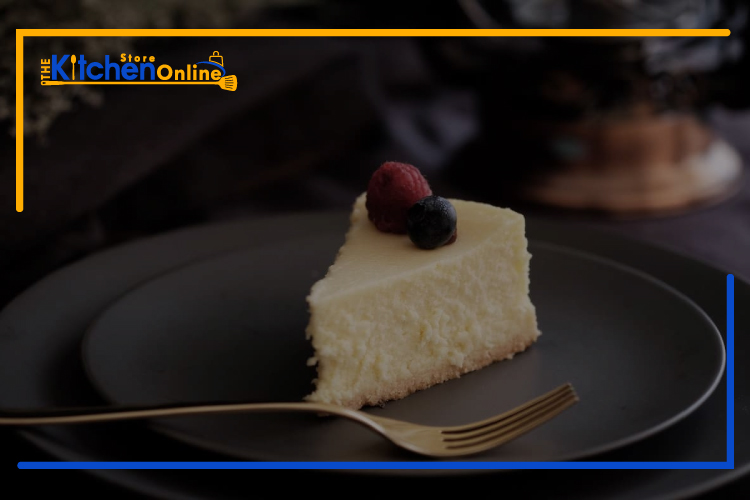Cheesecake is loved by everyone, right? You’re unlikely to find anyone who cannot resist the delicious taste of this classic New York cheesecake or the flavorful strawberry version.
In order to make a delicious cheesecake at home, you must first figure out when the cake is done, a tricky task.
Uncooked cheesecakes turn runny, sink in the middle, and lose their shape.
Cheesecakes are famous for their soft, creamy, melt-in-your-mouth texture, which can only be achieved by learning a few tips and tricks.
So, how can you tell if your cheesecake is undercooked? You can easily check cheesecakes by inserting a thermometer into their centers after they have baked. When the temperature reaches 150 degrees Fahrenheit, the cheesecake is ready. It may need to be baked again if it hasn’t.
You can easily check the doneness of the cake, and if it is undercooked, you can fix it easily.
To learn how to make cheesecake firmer, read on for a few easy tips:
How To Tell If A Cheesecake Is Undercooked
Cheesecakes must be cooked to perfection, just as any other baked dessert. In other words, this refers to selecting the right ingredients, measuring them correctly, and baking them for the right amount of time.
It’s unpleasant to eat a cheesecake that is undercooked because it’s runny, hard to serve, and unappealing to look at.
A well-baked cheesecake can be distinguished from an undercooked (or overcooked) one by knowing the subtle differences in their cooking times.
Below are some tips for detecting undercooked cheesecake:
Method #1: Use A Thermometer
If you’re unsure if your cheesecake is undercooked, check the temperature with an instant thermometer.
Check the temperature of your cheesecake using a thermometer by following these easy steps!
In order to get an accurate reading on the temperature quickly, it is helpful to have an instant-read cooking thermometer handy.
In the meantime, the cheesecake will not overbake, so you’ll save time.
- Take the temperature of boiling water to calibrate the thermometer. It needs to read 212°F.
- Once the cheesecake is halfway done, insert the thermometer half way into it. Make sure it doesn’t touch the pan completely. It is common for the edges of the cake to be warmer and firmer when well-cooked, so take the middle temperature.
- The cheesecake must have a temperature of 150°F in its center. Put a cooling rack under it and let it cool completely once it reaches this temperature.
- It might not be done when you take it out of the oven, so put the cheesecake in the oven again for a few minutes.
- In order to prevent the cake from cracking, stick the thermometer only once in the middle. If possible, replace the thermometer in the original hole rather than making a new one.
Method #2: Jiggle Test
A jiggled arm is a sign that something is wrong. Jiggle too little and it won’t be right. It is crucial that a perfectly cooked cheesecake has just the right amount of jiggle, and you can check it by using the following method:
- Give your cheesecake a gentle shake while wearing oven mitts and pressing your hands against the sides of the pan. Don’t break the still-wet cheesecake by being too rough. When you are using a water bath, be careful not to let water get into the pan.
- Observe how much the cake jiggles in the center. Approximately 2 inches of the cheesecake should jiggle slightly in the center if it is perfectly cooked. After the cake has cooled for a couple hours, turn off the oven.
- It is undercooked if the upper surface of the cake breaks or when the uncooked batter spills over the edges, so you need to put it back in the oven for a few minutes more.
- Cheesecake that doesn’t jiggle and is completely solid is probably overcooked. Take it out of the oven before it starts to crack.
Method #3: Toothpick Test
Another easy way to tell if a cake is done is to use a toothpick, however, this method is not the most accurate.
It is therefore often used as a temporary solution to avoid cooking without a thermometer when not having one on hand.
Cheesecakes are also poked with toothpicks to check the temperature. This is because you must be able to observe and assess what you are seeing in order to make an accurate conclusion.
Follow these steps to check your cheesecake for undercookedness using a toothpick:
- Make a hole in the middle of the cheesecake with a toothpick. It is possible to stick the toothpick a great deal in the cake if it is a small one. However, a long toothpick should be poked halfway through the cake. The toothpick should be withdrawn shortly thereafter.
- To see if the toothpick has remaining batter, check it with a mirror. It is an indication of undercooked cake if it is dripping liquid or feels wet.
- A completely dry toothpick that comes out clean is a sign of an ideal cheesecake.
- Try cooking the cheesecake for a couple of minutes more if it is undercooked. When using the cheesecake thermometer, make sure the hole is the same size as the hole on the cheesecake.
Method #4: Pressure Test
Using your fingers is the only tool needed for this simple test. The cheesecake needs to be handled with extra care since it is very simple and you do not want to damage the surface.
Here are step-by-step instructions on how to perform the pressure test on a cheesecake:
- Before touching the cheesecake, be sure your hands are clean because you will be using bare fingers. Soap them thoroughly and dry them completely.
- Check the cheesecake’s doneness by gently touching the center with one or two fingers. Be gentle.
- A cheesecake that is perfectly cooked feels firm with a little bit of give in the middle.
- The cake will need more time in the oven if your finger sinks into the center and comes out covered in batter.
- Use the same procedure to re-test it after another five minutes in the oven.
Learn more here about How To Reheat Scallops? The Best Way
Method #5: Browning Edges
Simply looking at the cheesecake can indicate whether it is undercooked or not. How to check:
- In order to know when the cake is done, watch the golden brown and puffy edge of the cake. This tells you the cake is nearly done.
- Compared with the pale center, the center must seem a bit wobbly. This means that it has been overcooked when it starts getting some color.
- The cheesecake is undercooked if it appears pale in the edges and still liquid in the center.
A cheesecake’s surface shine can also serve as a sign of readiness. Undercooked cheesecakes have a shiny surface, whereas fully cooked cheesecakes aren’t.
You should only remove the cake from the oven once all the shine has disappeared from the cake including the edges and the center.
How To Fix An Undercooked Cheesecake
A cheesecake can be tricky to make, and you might have to try several times before you succeed. No worries, there are simple ways to fix an undercooked cheesecake:
Method #1: Let it Rest
Time and rest are sometimes all you need. In contrast to other baked desserts, cheesecakes must set and cool for a few hours before they can be served.
A cheesecake should be refrigerated for a few hours or overnight before being sliced and served.
Cooling this cheesecake causes it to become firmer in the middle without any additional help, which is sometimes all that is needed to fix an undercooked cheesecake.
Method #2: Water Bath
Baking desserts in a water bath ensures that they are cooked evenly without cracking on the surface.
To ensure your cheesecake has the perfect texture, we recommend you use a water bath. Place your baking pan in a larger pan containing hot water, with the foil enclosing it.
Do not overfill it with water. Normally, 1 inch is adequate.
Cheesecakes can be fixed that is undercooked using this brilliant method.
The one thing you must remember, however, is that although this method works sometimes, re-baking your cheesecake is not advised as there is a high probability of it being ruined.
Take the cheesecake out of the fridge if it does not set after soaking it overnight. Once it has reached room temperature, slice it. Place the cake inside the water bath. Let it soak for 10 minutes.
As you wouldn’t want to burn the cake, set it at a low-to-moderate temperature.
The best way to test the cheesecake’s temperature is to use an instant cooking thermometer. At 150°F, the cheesecake is cooked to perfection.
Method #3: Slow Cooking
You can put your cheesecake back in the oven if you do not want to use a water bath, but you must be careful not to overcook it.
The cheesecake should be baked slowly to the perfect temperature (150°F) by setting the oven to a low setting.
Come back every five minutes and check it to be extra careful, but the process shouldn’t take more than 15-30 minutes.
Cheesecakes overcooked at the center or turning golden brown indicate overcooking.
Method #4: Frozen Dessert
Undercooked desserts can sometimes be used in a variety of ways rather than risking further ruin.
Frozen cheesecake is a great idea. You will have a delicious frozen cheesecake after freezing it for a couple of hours.
It can be turned into an enjoyable dessert for you and your guests if you let your creativity flow. It can be topped with fruit, dipped in chocolate, or both!
Related Questions
Please let us know if you have any additional questions about cheesecakes!
What is the difference between baked and no-bake cheesecake?
Basically, one is baked in a microwave whereas the other is not.
In addition, baked cheesecakes have eggs in their batter and are baked in an oven before being chilled.
However, no-bake cheesecakes rely on gelatin for shape and are directly placed in the refrigerator for cooling and solidification.
Texturally, there is also a distinction between the baked and non-baked varieties, with no-bake having a creamier, smoother texture.
How long does cheesecake last in the fridge?
The cheesecake can be stored in the refrigerator for up to 5 days. Make sure it is either tightly wrapped in plastic wrap or kept in an airtight box.
The best way to ensure the best results from your cheesecake is to keep it in the freezer until the night before you plan on serving it. To get the perfect texture and consistency, put it in the fridge overnight to thaw.
How long does cheesecake last out of the fridge?
Cheesecakes can be stored without refrigeration for a maximum of two hours.
When cheesecakes are left at room temperature, the high protein content and moisture content in the egg and milk create the perfect conditions for bacteria to grow.
When your cheesecake has cooled enough to be chilled after baking, or when everyone has enjoyed a piece, it is best to keep it in the refrigerator.
Taking the risk of leaving it on the counter for too long might be best if you start over with a new batch.
Here’s a video from Tasty that’ll show you how to make cheesecake!





